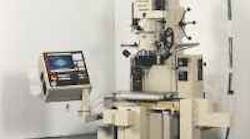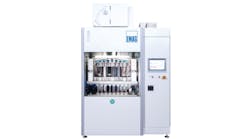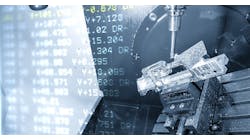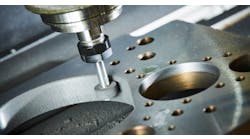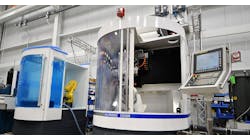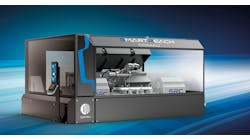By remanufacturing a specific type of machine, three companies fill product gaps between old manual machines and their new, expensive counterparts.
A new jig grinder costs about $350,000, and NASA Machine Tools remanufactures existing ones for approximately 1/3 he cost.
NASA Machine Tools' CNC Continuos Path Control System moves machine axes with resolution inputs as small as 0.000010 in.
Because of added CNC, a programmable Caxis makes contour grinding possible on a once manual jig grinder.
During remanufacturing, Vermont Machine Tool incorporates a separate computer for tool monitoring into a Fellows model 20-8 Hydrostroke gear shaper.
Adding CNC to a Barber-Colman model 16-16 gear hobbing machine transforms fixed-gear speeds/ feeds to programmable and variable.
Not only putting on CNC, Vermont Machine Tool also developed a stock-divider option for this once manual Liebherr hobbing machine.
National Acme replaces mechanical slides with CNC slides on its multi spindle automatics. Doing so enables old machines to use single-point tooling.
Vermont Machine Tool, NASA Machine Tools, and National Acme are playing favorites when it comes to machine-tool remanufac-turing. Each company specializes in one specific type or model of machine. And the common thread between the three firms is that their machines-of-choice for remanufacturing are considered high-accuracy machine tools with expensive new counterparts.
Customers don't want to scrap old, reliable manual versions, but often wish machines performed like new again. Remanufacturing brings equipment back into original or, in some cases, improved tolerances and enables the machine to accept some of today's new options. And putting CNC on these dinosaurs, probably the most challenging task in remanufacturing, makes it all possible.
Continuous-path jig grinding
A new jig grinder costs about $350,000, and there are about 4,500 existing Moore jig grinders that could be remanufactured for approximately 1 /3 of that cost. This large amount of potential business prompted NASA Machine Tools of Lincoln Park, N.J., to only remanufacture old No. 3 or G-18 Moore jig grinders into new NASA AGS-3 jig grinders. The company knew it couldn't be effective if it spread its concentration over a vast array of machine types.
Targeting one model or manufacturer, says Robert DeGeorge Jr., a NASA vice president, lets remanufacturers make and stock machine components in large quantities, so there are shorter turnaround times and no custom parts to design.
Besides returning machines to original specs, the added CNC creates a less manual-intense jig grinder. What was once a machine with dial readout positioning and 90-millionth repeatability, is now one with CNC positioning and 40-millionth repeatability.
Probably the biggest gain from adding CNC is continuous-path grinding. Now instead of just grinding holes and positioning, operators can grind contours. NASA's CNC Continuous Path Control System moves X, Y, C, U, and W axes with resolution inputs as small as 0.000010 in. The now-programmable C axis keeps the grind side (the high side of a grinding wheel) perpendicular to X and Y-axis movement for contour grinding. Manually, this is impossible.
NASA purchases Fagor controls, and together, the companies designed a C-axis normalcy in which an M-code signals the C axis as to whether it's at the left or right of the part. Other jig grinders use helical interpolation and math functions to calculate C-axis control.
NASA also adds precision roller ways for smooth table movement during contour grinding. This is because manual jig grinders have what is referred to as "stiction" or backlash. It's not a problem for simple grinding and positioning in one direction, but contour ground surfaces would be ruined by the jerky movement.
Taking the gears out of gearmaking machines
From a 35,000-lb machine, Vermont Machine Tool removes about 8,000 lb of traditional gear-train components along with a single-speed electric motor and replaces it all with individual AC servomotors and CNC drive systems. The process also includes adding precision-ground ballscrews, custom software, and other automated options.
The Springfield, Vt., company remanufactures Liebherr, Pfauter or Barber Colman gear hobbers, and Fellows gear shapers to create its new machine tools.
A CNC-transformed machine can monitor tools, offer push-button part changeovers, and readily accept such new-machine extras as automatic part load/unload equipment, quick-change tooling, and stock dividers.
For tool monitoring, a separate computer on a remanufactured Fellows model 20-8 or 50-12 Hydrostroke gear shaper controls both speed and processing of the shaper spindle. This provides adaptive-control capability. The system tracks cutting forces and tool condition to make adjustments accordingly. Standard machines just run, not taking tool wear into consideration.
Because of Vermont Machine Tool, changing from one part to the next on a Barber-Colman model 16-16 gear hobbing machine involves simply entering gear and hob data. The CNC calculates speeds and feeds,
which are now completely variable and programmable. Original machines had gear changing for speed and feed settings, as well as manually adjustable trip dogs for setting up the cycle.
Stock dividers
More gear manufacturers are reducing material costs using near-net forgings because there's less stock to machine off for finished size. Old-style disk forgings, for instance, can weigh as much as 250 lb before machining and then weigh only 160 lb as a finished part. Near-net forg-
ings have partially formed gear teeth and may require as little as 20 lb of material to be removed for finishing.
But gear hobbers are made to create a number of teeth in a blank diameter. Using near-net forgings means partial teeth must be located. A stock divider locates these teeth, so the machine can coordinate part rotation with cutter rotation.
According to company president Craig B. Barrett, Vermont Machine Tool is an engineering-intensive remanufacturer. This is apparent, he says, in its development of the stock-divider option for remanufactured machines. Stock dividers and other such new-machine features, adds Barrett, entice most shops to opt for cost-effective remanufacturing.
For example, a major off-road equipment manufacturer has a Vermont Machine Tool-developed stock divider on a remanufactured Liebherr hobbing machine. The company says it not only cuts near-net forgings, but it allows operators to recut previously cut oversize gears, all automatically.
CNC slides on multispindle automatics
Most of the multispindle automatics National Acme remanufactures with CNC slides date back to the '50s, with the oldest being a 1929 Acme-Gridley. The Cleveland, Ohio, company mounts CNC slides to cam-driven machines as big as a 6 in.-6 model, which means a 6-in. bar diameter capacity and six spindles (each holds one bar), and as small as a 1 in.-6.
The most popular customer reason for the upgrade, states Kirt Babuder, director of Engineering at Acme, is improved part accuracy. For multispindle machines, that means the CNC compensates for mechanical inaccuracies indexing from one spindle to the next.
In a run-off at National Acme, an eight-spindle machine (each spindle boring 30 parts) with a CNC package maintained a repeatability of 0.0003 in. across all the parts. CNC enables old machines to single-point turn as opposed to just shaving and, thus, obtain that level of accuracy.
Shaving is passing material between a fixed tool and a fixed roll, forcing material to size. Single-point and dovetail turning tools form the part in more of a lathe-type operation. Single-point tools can remove large amounts of bar-stock, make for faster tool changes, and speed up job changeovers. These remanufactured machines now accept standard, preset tooling for a low-cost option, and the CNC provides push-button tool offsetting and program changing. Tool changes that used to take 3 to 4 min, says Babuder, are slashed to 30 sec because of quick-change, single-point tooling.
This type of tooling also does the work of large bulky attachments associated with mechanical slides. Things like recessing attachments or threading heads, which are difficult to set and use, are replaced by single-point tooling.
For National Acme, adding CNC can also add complications. One of the company's toughest challenges is when a customer wants to still be able to run old attachments on a CNC-added machine. "They have good reason," says Babuder. "A recessing head or combination threading/die head, for instance, for a 1 1 /4 in.-6 machine costs between $15,0000 and $25,000, and shops don't want that kind of investment sitting on a shelf." To accommodate the request, National Acme combines electrical (CNC) systems with mechanical cam-and -roll systems.
They use four CNC-slide styles—a single-axis forming slide that moves the tool in on the X axis; a single-axis end-working slide independently mounted that moves in the Z axis; two-axis contouring slides for cutting in the X and Z axes; and a three-axis pickup and backfeed slide, which is basically a subspindle that eliminates secondary operations.
Do-it-yourself CNCOpenCNC is an unbundled, software-based machine-tool control from Manufacturing Data Systems Inc. (MDSI). It combines a soft CNC with soft PLC in a single application, and unlike traditional controls, the system uses no proprietary hardware or motion-control cards. The entire package arrives on a disk, so owners themselves can extend the lives of their aging machine tools by adding CNC to a manual machine or replacing obsolete controls on another. "A truly open system," says James Fall, a MDSI v.p., "means customers get the maximum number of choices concerning hardware, software, machine-data routing, and installation. MDSI offers installation project management or customers can do it themselves or contract a third party." OpenCNC is applicable to any age machine tool. According to Fall, it comes down to whether or not a machine's production output and worth justifies extending its life. A pure manual machine will most likely require more work before putting on the software package—adding ballscrews and a servo system for instance. NC and CNC machines with existing servo systems obviously make the retrofit easier. Features within the software optimize existing electrical systems and the machine tool's performance. For example, the system monitors machine events— such as cycle time, feeds/speeds, and cutter compensation—then sends the information to a built-in real time data base. It analyzes the captured data on-the-fly and in a millisecond will tweak the interrupt rate or servo-closing rate to match the machine's natural frequency. This lets endusers such as Tom Foster, CNC Mill Dept. Supervisor at Melling Tool, determine how hard they drive a machine tool. The Jackson, Mich., company increased the uptime of a 13-year-old vertical machining center from 20% (due to control problems) to 100% with OpenCNC. "Before the retrofit," says Foster, "the maximum rapid rate on the old control was 390 ipm. Now, it's 590 ipm, and for a 5,000-piece run, that makes a big difference." Through an open Application Programming Interface (API) users can also add new functionality, customize the controller, or integrate with third-party applications. For example, users can employ statistical process control (SPC) software to handle on-line measurements from machining operations. |
Contol compensates for wearRetrofitting and remanufacturing usually involves replacing or machining ballscrews but, GE Fanuc Automation says that isn't always necessary. With certain control-system features, retrofiters can accurately compensate for variable wear across an entire ballscrew length, thus avoiding the replacement or machining of an existing ballscrew. One such GE Fanuc feature, Backlash Acceleration Compensation, does away with hesitation occurring at direction reversals on a worn ballscrew and compensates for friction in the motor and on the machine. Another, called Bi-Directional Pitch Error Compensation, lets retrofiters define plus-direction and minus-direction compensation curves, and the control will jump from curve to curve, depending on the direction. This means that even though the wear is different throughout the length of the ballscrew, the control will accurately compensate for this variable wear. Along these same lines, GE Fanuc also offers an Extended Bi-Directional Pitch Error Compensation. Extended compensation provides 6,400 points of compensation, as opposed to a previous amount of 128 points/axis. More points are more accurate because compensation intervals are smaller. This enhanced Pitch Error Compensation option interpolates compensation between intervals and then divides the number of compensation counts evenly within the interval. Because ballscrews aren't replaced or reworked, both the retrofitter and the customer benefit. Retrofitters pass on a reduced cost to the user in the form of a reduced fee. Additionally, retrofits take less time, and short turnaround time means more retrofits can be done per year and machines spend less time out of production. |
